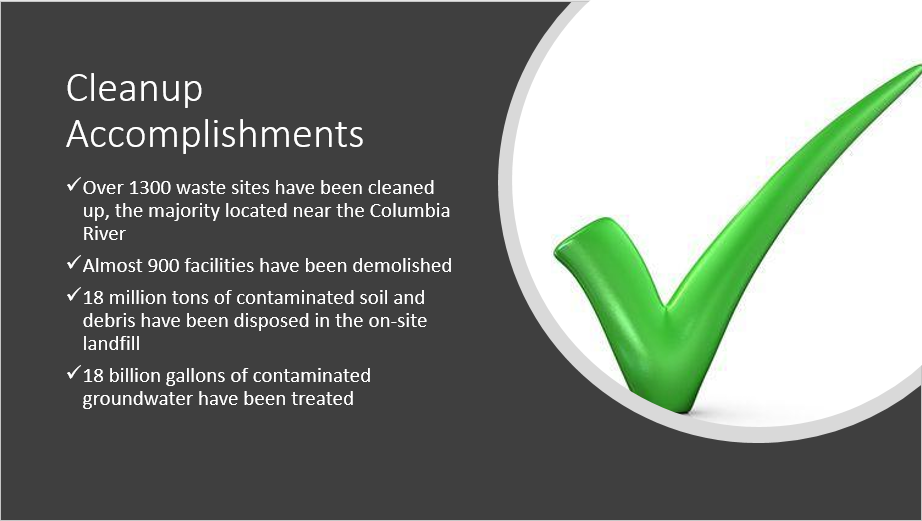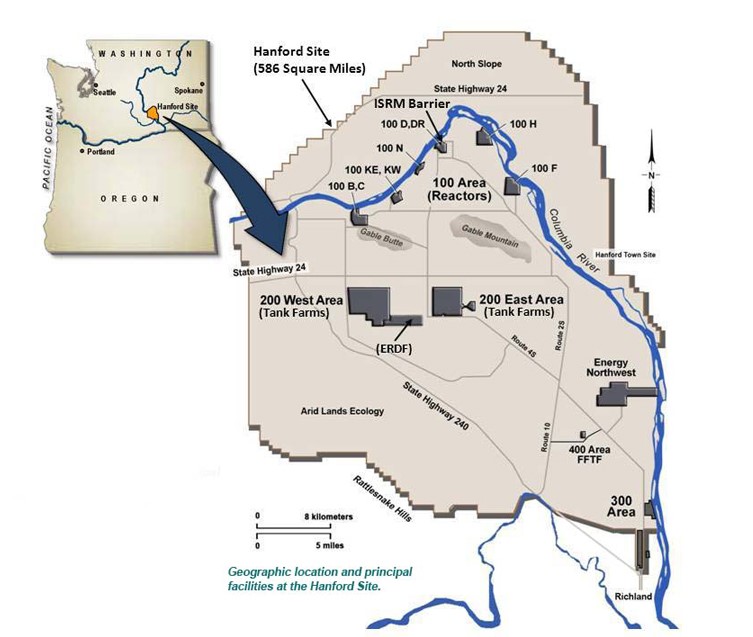Hanford Site Spotlight
History
The Hanford Site is located along the Columbia River in southeastern Washington and was originally inhabited by Native Americans, including the Wanapum Band and the Yakama, Nez Perce, Umatilla, Walla Walla, and Cayuse Tribes. Parts of the land were settled by non-Native Americans and used for irrigated orchards, farms, and ranches before World War II. The towns of Hanford, White Bluffs, and Richland were founded by some of these early settlers.
The Hanford Site is 586-square-miles and was created in 1943 as part of the Manhattan Project to produce plutonium for nuclear weapons. While some Hanford workers lived in the city of Richland, a trailer city consisting of thousands of trailers was constructed on site.

Hanford Trailer Camp - Looking South, 1944
Photo from at: Idyllopus Press

Title Description: Trailer Living, Camp Hanford, 1944
Photo available at: Idyllopus Press
The U.S. government eventually built nine plutonium production nuclear reactors along the banks of the Columbia River as the defense mission continued from throughout the Cold War years until 1987 when the last reactor ceased operation.

Workers laying graphite blocks in C Reactor in 1952.
Photo courtesy of U.S. Department of Energy
(3 of 10)

Photo: N reactor shown in the foreground with the KE and KW reactors in the background along the Columbia River circa 1960.
Photo courtesy of U.S. Department of Energy
(4 of 10)
Hanford Cleanup
Weapons material production mission ended in the late 1980s, and Hanford’s mission shifted from nuclear material production to environmental cleanup and waste management. More than 40 years of plutonium production led to over 2,000 contaminated soil sites, almost 200 square miles of contaminated groundwater, and millions of gallons of highly radioactive waste stored in underground tanks. The U.S. Department of Energy (DOE), the U.S. EPA, and the Washington Department of Energy signed a federal facility agreement in 1989 and continue to work together on cleanup.

Hanford Cleanup
The Hanford Site is divided into four National Priorities List (NPL) sites known as the 100, 200, 300, and 1100 Areas. The 100 Area includes nine deactivated nuclear production reactors along the northern stretch of the Columbia River, often referred to as the River Corridor. The 200 Area, located in Hanford’s Central Plateau, contain 56 million gallons of high- level radioactive waste in 177 aging underground tanks, the principal nuclear chemical processing and waste management facilities, several large waste disposal areas, and many other facilities. The 300 Area, approximately three miles north of Richland, contained research and development laboratories and former reactor fuel manufacturing facilities. The 1100 Area has been deleted from the NPL.

Map of Hanford Site Areas
Photo courtesy of U.S. Department of Energy
(6 of 10)
Soil Cleanup
There has been tremendous effort from DOE to clean up contaminated soil sites located near the Columbia River. The public has also expressed support for this portion of Hanford Cleanup since the Columbia River is a source of drinking water and home to many recreational activities. Cleanup activities have primarily consisted of digging out the contaminated soil and disposing of it in the on-site landfill.
For example, hexavalent chromium was used as an anti-corrosion agent in the piping of Hanford’s nine nuclear reactors and is a major contaminant of concern. It is highly mobile and waste sites have been excavated to the water table, down to 70 feet below ground surface, to protect groundwater and the Columbia River.

100-C-7 Soil Site Hexavalent Chromium Dig with Columbia River across the top
Photo courtesy of U.S. Department of Energy
(7 of 10)
Groundwater Cleanup
Groundwater cleanup through pump and treat operations is ongoing throughout parts of the River Corridor and Central Plateau. The large amount of groundwater contamination in Hanford’s Central Plateau was the result of liquid waste releases from plutonium production beginning in the 1940s. Contaminated liquids were discharged into cribs and trenches, similar to how home septic systems use a tank and drainage area, and moved deep into the ground and to groundwater. One of the groundwater plumes on the Central Plateau covers a four-square mile area and includes the chemical carbon tetrachloride (a solvent used in plutonium production processes), nitrates, hexavalent chromium, tritium, iodine-129, technetium-99, and uranium.

Photo: 200 West Pump and Treat Facility
Photo courtesy of U.S. Department of Energy
The 200 West Pump and Treat Facility began operating in 2012 and uses a network of wells and treatment technologies to treat radioactive and chemical contaminants. It is Hanford’s largest facility for treating contaminated groundwater and has treated over 3.3 million gallons so far. The system is planned to run for at least 25 years.
(8 of 10)
Hanford Today
Cleanup at the Hanford Site will continue for many years. The sagebrush habitat is of great value to wildlife. Cleanup efforts include using revegetation planting and boulders to provide a more natural looking and sustainable habitat for wildlife, which also saves taxpayer dollars. Wildlife, such as herds of elk and bald eagles, are often seen at the site. The land surrounding the majority of the Hanford Site is part of the Hanford Reach National Monument managed by the U.S. Fish and Wildlife Service.

Herd of Elk in Hanford 100-H Area
Photo courtesy of U.S. Department of Energy
(9 of 10)
Opportunities to Visit Hanford
The B Reactor was the world’s first full-scale plutonium production reactor. Construction of the B Reactor began in October 1943. It was named a National Historic Mechanical Engineering Landmark by the American Society of Mechanical Engineers in 1976, was listed in the National Register of Historic Places in 1992, was designated a National Historic Civil Engineering Landmark in 1994, and became a National Historic Landmark (NHL) in 2008. In December 2014, congressional authorization was obtained for the new Manhattan Project National Historical Park, which included the B Reactor Museum. Tours are free of charge and are open to visitors of all ages and from around the world.

(10 of 10)
